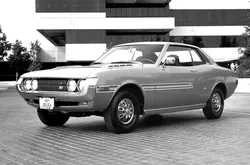

Toyota Celica: Generation 1 Overview
Discover the Toyota Celica Generation 1, featuring its design, specifications, and history. Explore the iconic model and its impact in Portugal.
The Toyota Celica, a name that has become synonymous with affordable performance and sporty design, first graced the automotive scene in 1970. The inaugural generation, designated the A20 and A35 series, laid...
Technical Specifications
Select Version
Dimensions
Engine
Driving
Others
History and Features
Mycarro AI
Apr 27, 2025
The Toyota Celica, a name that has become synonymous with affordable performance and sporty design, first graced the automotive scene in 1970. The inaugural generation, designated the A20 and A35 series, laid the foundation for what would evolve into a storied line of vehicles that catered to driving enthusiasts worldwide. This article delves into the characteristics, history, and legacy of the first-generation Toyota Celica.
Introduction to the First Generation
The first-generation Toyota Celica was introduced in 1970, characterized by its sleek silhouette and styling that combined classic coupe elements with a hint of sporty flair. The model was developed to appeal to a younger audience looking for a practical yet engaging driving experience. Positioned below the Toyota Corona in the lineup, the Celica provided accessible performance, a feature that quickly captured the attention of the automotive market.
Design and Features
The A20 and A35 series Celica stood out for its distinctive design, which featured a long hood, short deck, and an overall balanced aesthetic that emphasized its sporty character. The first model, the A20, came with a two-door hardtop body style, which earned praise for its aerodynamic lines and classic coupe appeal. Its well-proportioned dimensions made it not only visually appealing but also practical for day-to-day use.
The interior of the first-generation Celica was designed with the driver in mind. It offered a comfortable seating arrangement and user-friendly controls, allowing drivers to focus on the road. With a mix of vinyl and cloth upholstery, the cabin exuded a sporty ambiance, bringing together function and style. The dashboard included a straightforward instrument cluster, contributing to an efficient and unobtrusive driving experience.
Engine and Performance
Under the hood, the first-generation Celica was originally powered by a 1.6-liter (K series) four-cylinder engine that produced approximately 108 horsepower. This powertrain was paired with a standard four-speed manual transmission or an optional three-speed automatic. The combination of lightweight construction and adequate power made the Celica agile and responsive on the road, ideal for those seeking a spirited drive.
In 1973, Toyota introduced a new variant of the Celica, the A35, which featured a 2.0-liter (M series) engine that produced around 96 horsepower. This upgraded engine provided additional torque and a more robust driving experience. Both variations of the Celica were celebrated for their dependable performance and relatively good fuel efficiency for the time.
Racing Heritage
The first-generation Celica not only carved its place in the consumer market but also found success in motorsport. It quickly became a favorite among amateur racers and was involved in various racing events, notably Group 2 specifications in the early 1970s. Its success on the racetrack paved the way for Toyota's commitment to performance, ultimately leading to the development of the high-performance Celica variants in later generations.
Legacy and Impact
The legacy of the first-generation Toyota Celica extends beyond its production years. Its impact on the compact sports car segment can still be felt today, as it inspired new generations of Toyota models, including the newer Celica variants and the Supra. The combination of style, performance, and accessibility created a recipe that many automakers would attempt to replicate in the following decades.
As years went by, the first-generation Celica garnered a devoted fan base, and today it is sought after by classic car enthusiasts. The model is often recognized as a pioneer in the Japanese automotive industry, helping to establish Toyota as a global player in both performance and economy vehicle sectors.
Conclusion
The first-generation Toyota Celica (A20/35) is more than just a car; it is a representation of a transformative era in automotive design and performance. Its unique blend of sporty design, accessible performance, and racing roots set the stage for what would become a cherished name in the annals of automotive history. For car enthusiasts and collectors alike, the Celica remains a symbol of Toyota's early commitment to producing vehicles that are both fun to drive and practical for everyday life.
